
ŠKOFJA LOKA CASTLE
|
In 1202 the castle was mentioned for the first time as "strongly fortified castle in Loka". From 1270 on it was also used as administrative center for the souvereigns of Loka, when the bishops abandoned the Tower of Krancelj. This tower had been the first "castle" in Škofja Loka. In 1511 the new castle was partly destroyed by an earthquake, but bishop Philip had it rebuilt immediately, keeping its medieval looks. He used the material from the long ruined Tower of Krancelj for the rebuilding. First in the beginning of the 18th century bishop Johann Franz organized a new restauration. Among other things he let construct defensive towers in all four corners.
|
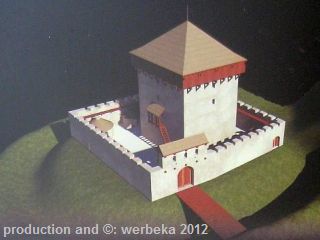
The Tower of Krancelj |
Furthermore he surrounded the castle with an extra wall. In 1890 the Ursulines bought the castle and again made a lot of rebuildings, so that it got the looks of today. In WWII the castle was occupied by German military and after the war it served for a while as a camp for prisoners of war and as military hospital, until it finally was taken over by the town in 1959. In the middle of the 20th century archeologists found the rests of the Tower of Krancelj, which had been overgrown in the meantime. At that site they found also many tools, weapons and items of everyday use from the medieval times.
Now we have approached things that concern the museum, as many of those artefacts are shown there.
|

A drawing by the architect Viljema Trea,
whom the Ursulines engaged for the rebuilding of the castle |
But we start in the departement for handicraft and the guilds. The guild system evolved here since the 15th century.
The first privilege for a guild was granted by bishop Johannes and is dated from the year 1451. There are different exhibited objects, like charters, seals, guild chests, pitchers, candleholders and more. Everything is well labelled and assigned to the respective guild.
The power of the guilds were dramatically abridged through the French Revolution and of industrialization - and finally forbidden in the Industrial Code of 1859. Though the customs of each guild, for instance the procession on the day of the guild's saint, were continued even after that by the craftsmen, as long as until WWII.
|
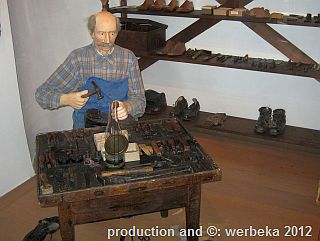
|
Now we come into a room with old furniture from the 18th century, namely from the kin of the Kalans, who even are mentioned literarily in the "Visoška kronika".
Next is the ceramic exhibition, which shows objects from the so called "painted civil ceramics of Loka", dating back to the 16th and 17th century. They were found at excavations in the Komun (community shed), which was situated at the Main Square. In spite of the painting and the high quality of the items, they were in everyday use. The motives are partly fetched from the fauna and flora, but most of them show geometrical forms. There are as well such, that are marked with a date, or that show a letter of the alphabet.
|

|
In the cellar there is another outstanding rarity. Here copies of gothic frescoes are shown, some as old as from the 14th century. The originals were painted in the churches in the neighbourhood.
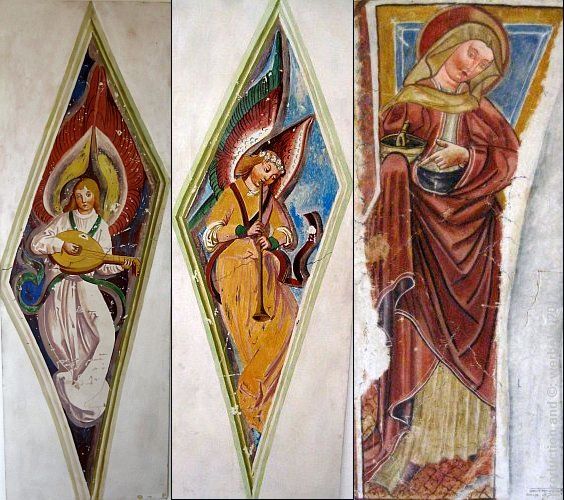
The fresco to the left and that in the middle are made by the same painter, from somebody in the circle around Jan Polack. The "Angel with a Guitar" and the "Angel with a Trumpet" were painted in 1502. The right fresco, "The Wise Virgin" was made by the "Master of Suha" in the mid 15th century.
There is also a small area in the museum, which contains pictures of painters from the 20th century.
Very interesting is the staircase, that leads down to the cellar of the castle. But probably you will notice this first, when you want to ascend again. The backside of the steps is built up with transparent material, in order to be able to see the rocks of the hill behind them. In another room you get felt slippers to pull over your shoes and then you may cross a room with a transparent floor, which also lets you see through, down to the stones.
Now we go up again, directly to the second floor, where in the corridor you can see more pictures from Slovenian painters.
Another corridor is dedicated to more recent history. It contains mainly photos, which show the era of the two world wars, as well as the evolution of Škofja Loka after WWII.
From the upper floor one also has a view - through a glass wall - onto the castle's chapel, which is situated one floor below. |

|

|
There the four so called "Golden Altars" can be admired. All four originally come from the village church in Dražgoše, which was dedicated to St. Lucia and which as well was a pilgrimage church. All of the altars were made in the 17th century.
Apart from all this, there is much information about old handicraft on the upper floor. On the picture to the right you can see a machine, which was used for producing paper.
|

|
The nuns of the Clarisses started already in the early 18th century to make paper flowers, with which they decorated altars and pictures of saints. At that time Škofja Loka also was a centre for linen manufacturing, which in turn helped to evolve dye works. Bobbin lace making, as well as the production of sieves and hats are also mentioned and explained.
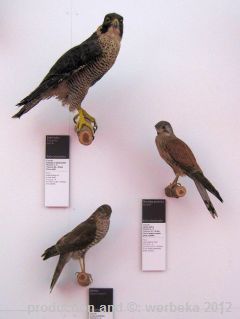
|
But not only the products of handicraft are described, also devices needed for farming and cattle holding are shown.
For the linen you need flax; the hatmakers used the wool from sheep and the hair of hares for their production, and so on.
The last department inside the castle is dedicated to the animals. Here we find stuffed examples of the fauna in the environment. Among them there are a wolf and a bear as well as foxes, a lynx, birds and a lot of other creatures.
|
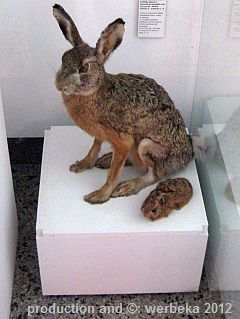
|
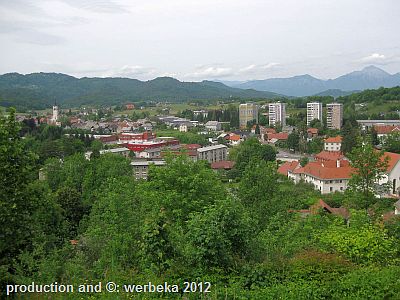
|
You should also take some time to see the open air museum, that can be reached from the yard of the castle and that also has been designed carefully. Among other things there is an old mill, a herb garden and a fruit garden, an old well and even an open air theatre.
Last, but not least there is also a lookout point, from which you have a view over some newer parts of Škofja Loka, plus a sight of the up to 2000 meters high mountains in the background.
I have tried to show you the manifoldedness of the castle's museum with a couple of pictures.
|
It is, of course, much better to be there in real life and to be able to look at all exhibited material.
However, I find, that this museum is outstanding among the castle museums in Slovenia and that this alone makes a visit in Škofja Loka worthwhile.
© Bernhard Kauntz, Wolvertem, Belgium 2012
Back to  or to the or to the  of of 
last update: 17.8.2012 by webmaster@werbeka.com
|













